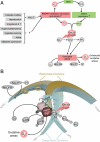Nitric oxide synthases: regulation and function
- PMID: 21890489
- PMCID: PMC3345541
- DOI: 10.1093/eurheartj/ehr304
Nitric oxide synthases: regulation and function
Abstract
Nitric oxide (NO), the smallest signalling molecule known, is produced by three isoforms of NO synthase (NOS; EC 1.14.13.39). They all utilize l-arginine and molecular oxygen as substrates and require the cofactors reduced nicotinamide-adenine-dinucleotide phosphate (NADPH), flavin adenine dinucleotide (FAD), flavin mononucleotide (FMN), and (6R-)5,6,7,8-tetrahydrobiopterin (BH(4)). All NOS bind calmodulin and contain haem. Neuronal NOS (nNOS, NOS I) is constitutively expressed in central and peripheral neurons and some other cell types. Its functions include synaptic plasticity in the central nervous system (CNS), central regulation of blood pressure, smooth muscle relaxation, and vasodilatation via peripheral nitrergic nerves. Nitrergic nerves are of particular importance in the relaxation of corpus cavernosum and penile erection. Phosphodiesterase 5 inhibitors (sildenafil, vardenafil, and tadalafil) require at least a residual nNOS activity for their action. Inducible NOS (NOS II) can be expressed in many cell types in response to lipopolysaccharide, cytokines, or other agents. Inducible NOS generates large amounts of NO that have cytostatic effects on parasitic target cells. Inducible NOS contributes to the pathophysiology of inflammatory diseases and septic shock. Endothelial NOS (eNOS, NOS III) is mostly expressed in endothelial cells. It keeps blood vessels dilated, controls blood pressure, and has numerous other vasoprotective and anti-atherosclerotic effects. Many cardiovascular risk factors lead to oxidative stress, eNOS uncoupling, and endothelial dysfunction in the vasculature. Pharmacologically, vascular oxidative stress can be reduced and eNOS functionality restored with renin- and angiotensin-converting enzyme-inhibitors, with angiotensin receptor blockers, and with statins.
Figures




References
-
- Schuman EM, Madison DV. A requirement for the intercellular messenger nitric oxide in long-term potentiation. Science. 1991;254:1503–1506. - PubMed
-
- Rapoport RM, Draznin MB, Murad F. Endothelium-dependent relaxation in rat aorta may be mediated through cyclic GMP-dependent protein phosphorylation. Nature. 1983;306:174–176. - PubMed
-
- Förstermann U, Mülsch A, Böhme E, Busse R. Stimulation of soluble guanylate cyclase by an acetylcholine-induced endothelium-derived factor from rabbit and canine arteries. Circ Res. 1986;58:531–538. - PubMed
Publication types
MeSH terms
Substances
Grants and funding
LinkOut - more resources
Full Text Sources
Other Literature Sources
Medical
Molecular Biology Databases

